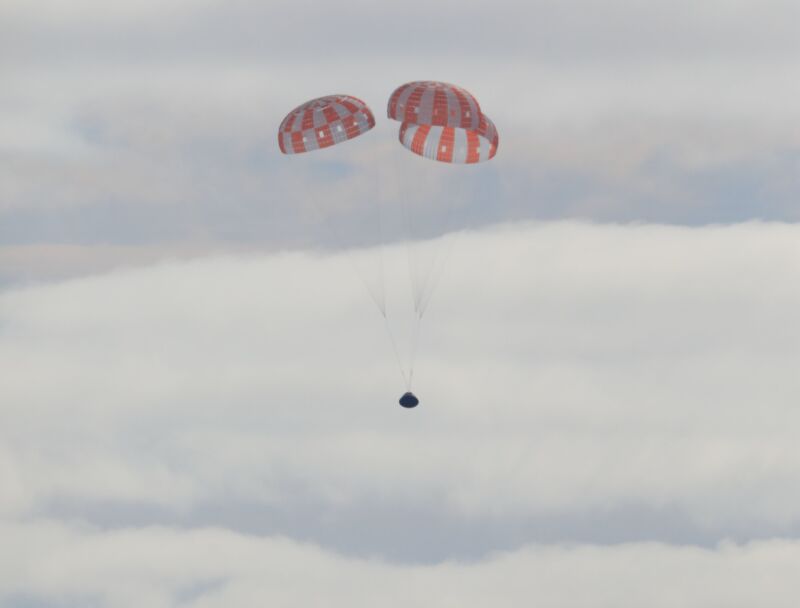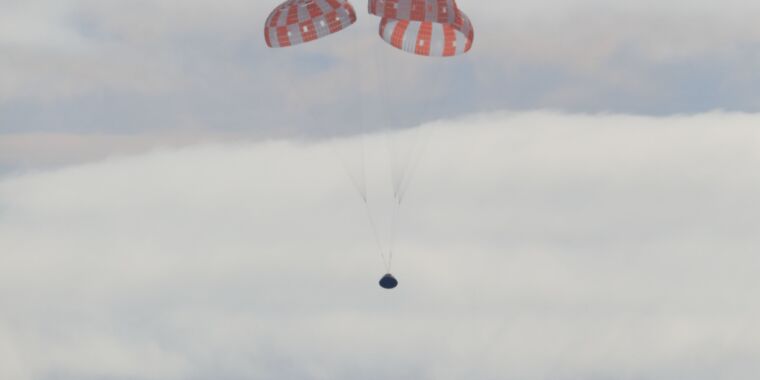
NASA
The first step of a journey is often the hardest. So it’s worth taking a moment to reflect on the fact that NASA has just taken the vital first step towards a permanent presence in deep space.
Amid a backdrop of blue skies and white clouds, the Orion spacecraft crashed Sunday into the Pacific Ocean, a few hundred miles from the Baja Peninsula. This ended the Artemis I mission, a 25.5-day spaceflight that showed NASA is nearly ready to fly humans back into deep space.
That hasn’t happened in half a century. Sometimes it seemed like it would never happen again. But now it sure is happens.
NASA’s progress back to the moon, and one day possibly to Mars, has been lethargic at times. The political process that has led NASA to this point over the past few decades has been messy and prompted by parochial pork projects. But on Sunday, there was no denying that this process has moved NASA, the United States, and dozens of other countries participating in the Artemis program to the point where their human deep space exploration program is a very, very real thing.
It’s been a long time coming.
False starts
The last Apollo mission ended this month, in 1972. For a time, US presidents and the space agency were content to focus human exploration on low Earth orbit, with the development of the US space shuttle and plans to build a large space station.
Eventually, however, some people began to get restless. On the twentieth anniversary of the Apollo 11 landing, in 1989, President George Bush announced the Space Exploration Initiative, a long-term commitment to human exploration of deep space. The plan was to complete a space station and have humans on the moon begin building a base there by the turn of the century.
What happened next wasn’t particularly pretty. Some people at NASA, including Administrator Dick Truly, strongly disagreed with Bush’s idea. They were concerned that the lunar plans would disrupt the space station. Infamously, NASA conducted and leaked a 90-day study that suggested Bush’s plan could cost half a trillion dollars or more. Since Congress had no appetite for such a budget, plans for the moon died.
They would remain dormant for nearly a decade and a half before President George W. Bush resurrected them. Like his father, Bush envisioned a daring plan to send humans back to the moon, where they would learn to operate in deep space and then go to Mars. This became the Constellation program.
This vision was well received in the aerospace community, but then three bad things happened. NASA’s new administrator, Mike Griffin, chose a large and very expensive architecture – the Ares I and Ares V rockets – to get people back to the moon. International partners were largely ignored. And then neither the president nor congress fought for the full funding the program would need to survive.
Constellation was years late, and way over budget, when President Obama canceled it in 2010. It was then that Congress stepped in and saved the Orion spacecraft, launched in 2005, and established the design for a new rocket, the Space Launch System. . The development of these programs meandered through most of the past decade, costing more than $30 billion, with no clear destination. That changed in late 2017 when Vice President Mike Pence announced that NASA would land humans on the moon.
This led to the formulation of the Artemis program in 2018 and 2019. It’s far from perfect, but more than functional. Moreover, it built on past failures. Where the Constellation program had a purely government-led architecture, Artemis increasingly relied on commercial space. Artemis also sought to build international cooperation from the start, through a series of bilateral agreements known as the Artemis Accords. And as of this year, the program is fully funded.
“Fifty years ago we went as a country, as a government,” NASA Administrator Bill Nelson said Sunday after Orion’s landing. “Today we are going not only with international partners, but also with commercial partners. It is the beginning of the new beginning.”
A rare alignment
Numerous technical challenges remain for the Artemis program, including the development and testing of SpaceX’s complex Starship lunar lander and Axiom’s work on spacesuits that can operate in the lunar environment. Both contracts, which will be awarded in 2021 and 2022 respectively, are likely to take time and patience to come to fruition.
None of this will happen anytime soon. Artemis II is unlikely to fly before 2025, and the actual lunar landing mission won’t take place until later this decade, perhaps 2027 or 2028.
But taking a long-term view is instructive here. The two other post-Apollo deep space programs failed because they lacked political backing, funding, or both. Artemis is different. It has both political support and funding. Remarkably, virtually every aspect of space policy—the White House, Congress, international allies, traditional aerospace, commercial space, and the space agency—has aligned with the broad goals of Artemis.
That kind of support hasn’t existed for a program like this since the 1960s and Apollo. And that fervor really only crystallized in the melting pot of national tragedy that followed the assassination of President John F. Kennedy. There has been nothing quite like that unifying event for Artemis. Rather, elements of this program have had to survive in four different and very opposing administrations, from Bush to Obama to Trump to Biden.
“You see a nation torn by partisanship,” Nelson said. “That doesn’t exist here. NASA is impartial. R’s and D’s come together to support us.”
Amazingly, the politics are thus sorted. Now it comes down to the technical implementation. Engineering is hard, but at least it is based on reason, unlike space policy. Artemis I has proved to be a technical success. Do you think SpaceX can’t make a rocket to land on the moon? Or, working with a NASA design, can’t Axiom make spacesuits to keep the lunar dust at bay?
Sure, they can, and they will.
A lack of coordination?
NASA is also taking steps to address one of the last major problems with Artemis, a lack of coordination. Johnson Space Center in Houston is responsible for Orion and training the astronauts. Marshall Space Flight Center in northern Alabama builds the SLS rocket and manages development of the lunar lander. Kennedy Space Center launches the missions.
As a result, several organizations and outside consultants have criticized NASA for not having a “program office” to coordinate the myriad elements that will go into the Artemis mission.
For example, NASA’s Office of Inspector General recently stated, “Unlike the first manned missions to the lunar surface under the Apollo program, NASA does not have a general NASA program manager overseeing the Artemis missions or a prime contractor, as in the Space Shuttle. program, serving as the leading system integrator.” The concern is that without such an officer the program would lack cohesion and see infighting for influence.
But such an office is definitely on the way. Mike Sarafin, the senior NASA engineer who successfully served as mission manager for Artemis I, will be the “mission development manager” for Artemis III. In an interview, Sarafin said that an Artemis Program Office is still in the development phase and he did not want to discuss details yet. However, it appears his role will include overall planning and coordination for the complex flight to the lunar surface, bringing together the SLS rocket, Orion spacecraft and Human Landing System programs under one roof.
Sarafin looks like an excellent choice to lead the development of Artemis III. He led the Artemis I mission through countless delays, overcame liquid hydrogen fuel challenges and not one but two hurricanes in the weeks before the mission finally launched. And yet, through it all, he and his team brought home a spacecraft in excellent condition, meeting or exceeding all of its goals by splashing down on Sunday.
Another criticism of Artemis is that it simply repeats the Apollo program. If Artemis dies out after a few missions, then such criticism is justified. However, give the broad support for what is happening today, NASA now has a credible path forward to not only explore the moon’s south pole, but also learn to live and work in deep space, and eventually people deeper into the solar system to submit.
“There we did the impossible, made it possible,” Nelson said of Apollo. “Now we’re doing it again, but with a different goal. This time we’re going back to the moon to learn how to live, work, create.”
Artemis’ greatest conceivable success would be that it has a durability not enjoyed during the Apollo era. Given this weekend’s success, such a future for NASA is up for grabs. They and their partners just need to keep performing as brilliantly as they did last month.

